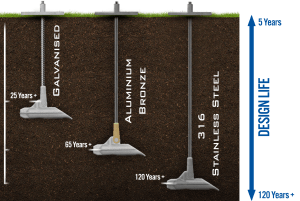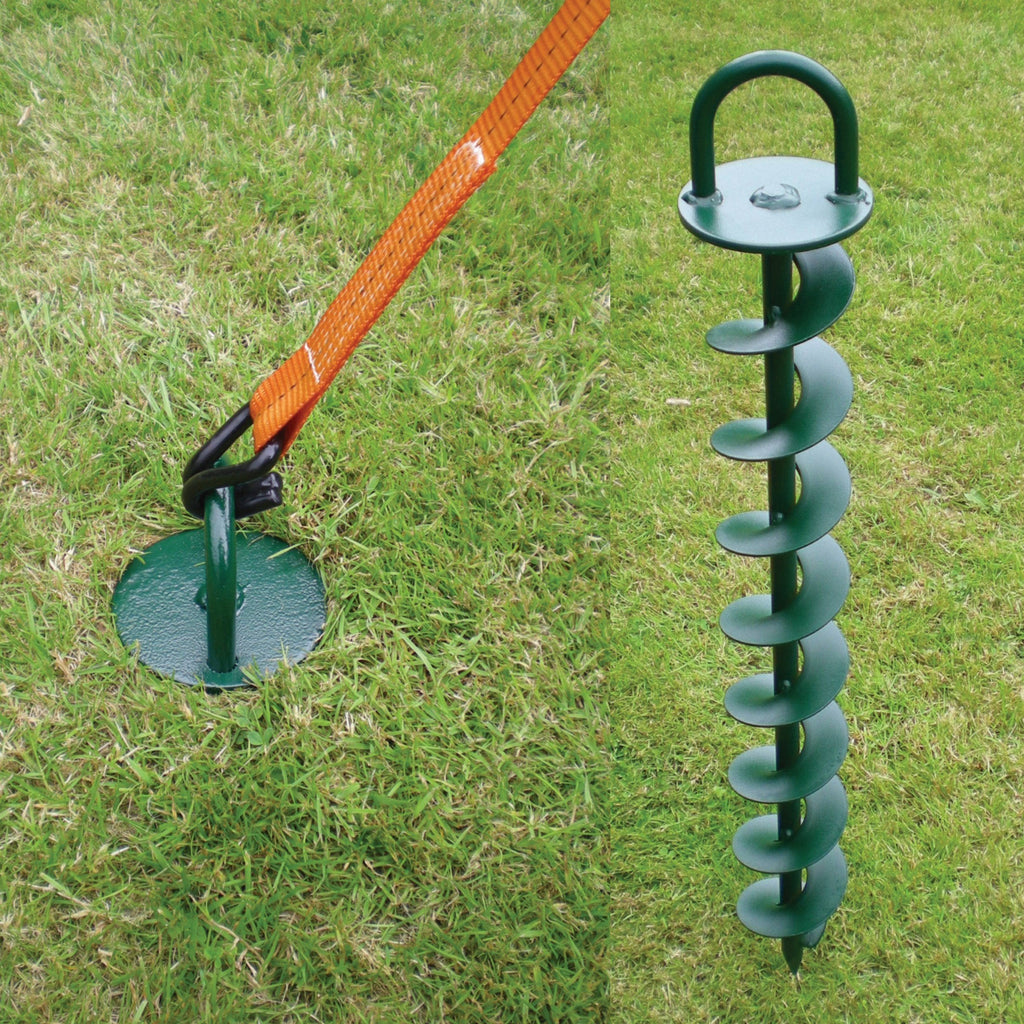How Sturdy Earth Anchors Job: A Comprehensive Overview to Soil Anchoring Solutions
Durable Earth anchors play a crucial role in giving security and support in various construction applications. By installing deeply into the ground, they resist lateral and upright pressures efficiently. Various types of supports provide to various soil problems, making them versatile. Understanding their mechanics and installment strategies is crucial for optimizing efficiency. What aspects affect their performance, and exactly how do they contrast to traditional techniques? The responses might amaze you.
Recognizing Sturdy Earth Anchors
Durable Earth supports act as important elements in numerous building and construction and landscape design projects, giving stability and assistance in challenging dirt problems. These supports operate by being embedded into the ground, where they withstand vertical and lateral pressures. Their style enables protected accessory to structures, guaranteeing they continue to be secured against dirt activity or external loads.The performance of durable Earth supports largely relies on the kind of soil and the support's setup depth. Proper setup strategies are crucial, as they identify the support's holding ability. Ecological elements, such as dampness and freeze-thaw cycles, can additionally influence performance.These anchors are regularly used in applications ranging from protecting fencings and preserving walls to supporting temporary structures during damaging climate condition. Recognizing the concepts behind durable Earth supports is necessary for professionals seeking to enhance the resilience and security of their projects.
Kinds Of Heavy-Duty Earth Anchors
Various kinds of sturdy Earth anchors are made to satisfy details requirements based upon soil conditions and task needs. Helical anchors, including screw-like blades, work in softer soils, offering high tons capabilities and easy setup. Driven supports, which are hammered right into the ground, appropriate for rocky surfaces and supply prompt tons assistance. Tie-back anchors are typically used in retaining wall surface applications, permitting lateral assistance by anchoring right into the ground at an angle. Another kind is the cast-in-place anchor, suitable for concrete applications, as they are incorporated into structures for enhanced stability. Lastly, soil screw anchors are versatile options that can be made use of in different dirt types, offering trusted tension and compression capacities. Each type offers distinctive applications, guaranteeing security and safety and security in building and construction and landscaping jobs. Recognizing these alternatives permits educated choices in choosing the proper Earth anchoring service.
The Mechanics of Soil Anchoring

Comprehending the technicians of dirt anchoring needs an examination of different kinds of Earth anchors and their installation techniques. Each support type presents distinct features that affect its efficiency in various dirt problems. Appropriate setup techniques are necessary for taking full advantage of the securing system's stability and performance.
Kinds of Earth Anchors
Earth supports, essential components in soil anchoring systems, come in several kinds, each designed for certain applications and dirt conditions. The most usual kinds include screw anchors, which are turned right into the ground, giving solid lateral resistance. Helical supports include blades that permit effective setup in numerous soil types, making them suitable for both short-lived and irreversible applications. Driven anchors, normally made from steel, are hammered into the soil and are efficient in rough or dense environments. Auger supports make use of a helical design to assist in setup in softer dirts. Plate anchors are composed of a flat plate buried flat, dispersing lots over a bigger area, perfect for applications requiring high lots capabilities in cohesive dirts.
Setup Methods Described
Appropriate setup strategies are important for the efficiency of soil anchoring systems. The procedure usually starts with website assessment, verifying the picked area can sustain the anchor's tons. After determining the proper support kind, correct opening deepness and angle have to be developed. The setup includes driving the support into the ground making use of customized devices, such as hydraulic or manual chauffeurs, to attain finest embedment. Post-installation, tensioning the anchor is essential to assure security; this is commonly confirmed with load testing. Additionally, surrounding soil problems must be monitored to stop displacement. Complying with these techniques not only improves the anchor's performance yet likewise lengthens its lifespan, giving reliable assistance for numerous applications.
Applications of Heavy-Duty Earth Anchors
While durable Earth anchors are frequently connected with building and landscaping, their versatility includes a variety of applications throughout various industries. In civil design, they offer essential support for maintaining wall surfaces, making certain security in areas susceptible to dirt erosion. The aquatic market utilizes these anchors for safeguarding docks and marinas, avoiding movement triggered by trends and currents. Additionally, in the telecommunications industry, durable Earth anchors are substantial for stabilizing cell towers and various other high frameworks versus wind forces. Agricultural applications likewise profit, as these anchors can protect structures like greenhouses and animals fence, ensuring they hold up against severe weather. In eco-friendly power projects, such as wind ranches, Earth supports play an essential role in securing wind turbine foundations, enhancing general safety and security and efficiency. This wide range of applications highlights the flexibility and dependability of durable Earth supports throughout numerous areas.
Benefits Over Standard Anchoring Methods
Although standard anchoring techniques have long been counted upon for stability, sturdy Earth supports provide considerable benefits that enhance performance and effectiveness. One significant benefit is their exceptional load-bearing ability, which enables them to stand up to better pressures without failing. This toughness makes them perfect for demanding applications, such as in building and utility installations.Additionally, heavy-duty Earth supports are developed for deeper setup, giving higher stability in different dirt conditions, including sandy or loose click over here soils. Their resistance to corrosion and ecological elements guarantees a longer life-span and minimized maintenance costs contrasted to traditional methods.Moreover, these anchors can be set up with minimal disturbance to the surrounding location, maintaining the honesty of the landscape. On the whole, sturdy Earth supports provide a reliable and reliable option for anchoring needs, exceeding the constraints usually related to typical anchoring techniques.
Installment Process and Ideal Practices
The setup procedure for soil anchoring remedies begins with extensive prep work and site evaluation to ensure peak efficiency. Following this, a step-by-step installation guide supplies clear directions for effective execution (tensile load anchors). Complying with these best methods is crucial for accomplishing lasting and trusted anchoring results
Prep Work and Website Assessment
Effective preparation and comprehensive site evaluation are important action in the installation of dirt securing solutions. Before installment, the soil kind must be examined to identify its bearing capability and viability for anchoring. Performing a geotechnical study can offer essential information about soil composition, moisture levels, and prospective ground motion. In addition, recognizing existing frameworks, plant life, and utilities is important to stay clear of interference throughout installation. The location should be free from particles and barriers to ensure secure accessibility for equipment. Weather condition conditions should likewise be monitored, as damaging conditions can affect both safety and setup efficiency. By thoroughly preparing the site and assessing all relevant elements, the likelihood of successful support efficiency is considerably boosted.
Step-by-Step Installment Overview
An extensive installment procedure is important for accomplishing excellent performance of soil securing remedies. The installment starts with choosing the ideal support kind and ensuring the website is clear of particles. Next off, appropriate hole positioning is figured out based upon lots needs. Once the area is established, holes are drilled to the specified depth and size using the proper tools. The support is then inserted into the hole, making certain it is aligned properly. After safeguarding the support, soil is backfilled and compacted to enhance stability. It is important to comply with producer guidelines throughout the procedure. A post-installation assessment verifies that the supports are properly located and functioning as meant, offering trustworthy assistance for the intended application.

Maintenance and Inspection of Earth Anchors
Routine maintenance and examination of Earth anchors are essential for making sure long-term performance and stability. Periodic checks permit the very early detection of concerns such as corrosion, loosening, or dirt movement. Examiners must look for indicators of rust or deterioration on the anchor components, specifically at the link factors. Additionally, the bordering soil ought to be examined for erosion or changes in wetness content, which can influence support effectiveness.It is advisable to develop a regular examination routine, preferably at the very least annually, depending upon ecological conditions. Throughout assessments, Recommended Reading all visible components must be cleaned up to remove dust or particles that might conceal possible problems. Any signs of distress, such as tilting frameworks or uncommon settling, must motivate immediate evaluation. Correct paperwork of inspections can help in tracking support efficiency over time and facilitate timely upkeep actions, making sure the supports stay practical and reputable.
Frequently Asked Inquiries
What Products Are Heavy-Duty Earth Anchors Commonly Made From?
Sturdy Earth supports are normally created from long lasting materials such as galvanized steel or stainless steel, making sure stamina and resistance to rust. These products offer long-lasting assistance and security in different dirt conditions and applications.
How Do Dirt Problems Impact Support Performance?
Dirt problems considerably affect anchor efficiency. Factors like this such as dirt type, dampness material, and compaction influence the support's grasp and stability, with cohesive soils often offering much better resistance than sandy or loose dirts, impacting overall effectiveness.
Can Heavy-Duty Earth Anchors Be Reused After Removal?
Heavy-duty Earth anchors can be recycled after removal, supplied they are checked for damages and wear. Correct cleaning and upkeep boost their longevity, ensuring effective efficiency in succeeding installments when problems permit for safe reinstallation.
What Are the Ecological Effects of Making Use Of Earth Anchors?
The ecological impacts of making use of Earth anchors consist of possible dirt disruption, interruption of local communities, and possible contamination of groundwater. Nevertheless, if made use of responsibly, their benefits often outweigh these concerns, promoting stability in various applications.
Exactly how Do I Pick the Right Anchor for My Project?
